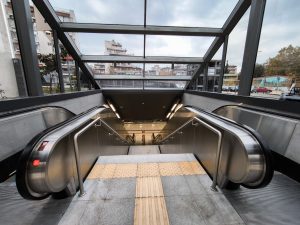By Vasilis Kyriakoulis
Never before in modern Greek history has an infrastructure project managed to turn into a such a “collective trauma”. The Thessaloniki metro became synonymous with an easy joke, a theatrical performance, gave birth to new words, even provoked hunger strikes. It destroyed people’s lives.
A 9.6-kilometre underground line, which, together with its extension to Kalamaria, cost three billion euros and took over 30 years to complete, consolidated the sense of unfulfillment in an entire city, definitively undermining the relationship of trust between local society and politics.
From the ‘Kouvela hole’ in the 1980s to the inauguration ceremony of the Thessaloniki Metro, a whole generation has walked with the unshakeable constant of unfulfilled promises. The two metro models, “Kostikas” and “Yorikas”, as they were christened by George Souflias, these days have certainly met again somewhere and continue to tell stories and anecdotes about the sheet metal, the construction sites, the progress of the project and the… extensions of the main line!
Eleni Devetzi, 51 years old, runs a slipper shop opposite the “Analipsi” station on Delphi Street. She bursts into tears at the mere mention of the word metro. She flips through the binders with countless documents, publications and photos from mobilizations held by shopkeepers with black flags and banners whose shops were shut down due to the construction
“Zafiris Tziutzias had a glassware shop next to mine. We had a great struggle together. He had even gone on a hunger strike to raise awareness to those in charge. A solution was never found. The man closed the shop and is now dead. We went to the courts, to politicians. Nothing… Here I still have the company’s document saying that the construction would last 12 months.”
“The digging started in 2009, but the construction was finished in 2019. All these years I have seen sheet metal. I was suffering from heart palpitations, I wanted to migrate. Of the shops that were here in the neighborhood at that time, only three or four managed to stay to this day. I am haunted by this project. What I am waiting for now, because the store is privately owned, is to be able to rent it after the metro is operational and go home,” Devetzi said.
The Thessaloniki Metro was a source of inspiration for Novi Vassiliadou who directed a theatrical performance about “the play that everyone hears but no one sees”.
“I was ten years old when the construction started. I grew up in a working-class city that was trained to wait ‘as long as it takes.’ Announcements, postponements and extensions seemed to laugh behind our backs, underestimating our intelligence and completely dislocating the very concept of time. Faced with the collective trauma of a generation that grew up in conditions of “necessary stagnation”, we decided with the TROCHIES group to respond by creating the performance “ATTENTION: WORKS ARE BEING PERFORMED”, that is, our own “work for the work”.
Through a thorough investigation, which began in February 2023, we learned about shops that were closed, properties that were destroyed, courts that were lost, artifacts that were shredded, and exorbitant compensation paid. We asked ourselves what “development” ultimately means, who it affects, and how it affects our lives. Our play may not have had “construction guarantees”, but it managed to complete 65 performances all over Greece, leaving behind a book with extracts from our research and text. It will be somewhere to remind us how we got here,” she explains.

A snapshot of the Thessaloniki Metro, Friday 29 November 2024.
(GIORGOS KONTARINIS/EUROKINISSI)
Haris Christodoulou was a student when the public debate on the construction of the metro in Thessaloniki began. she is now teaching at the Aristotle University of Thessaloniki as Associate Professor at the Department of Architecture. Although she has already toured one of the metro stations with his students, she finds it hard to believe that the project is complete.
“My feeling is that the city doesn’t believe it yet and I don’t know if they even trust it. I personally feel desensitised. I have to experience it to believe it. In my opinion, the city is not organizationally ready for the metro to start operating. I believe the whole city is running behind the subway when it should be the other way around. An example of how the metro is designed to serve the city is the one in Vienna,” Christodoulou said.
20 years ago, in 2004, Yannis Toskas, a transport engineer, was president of the Thessaloniki Urban Transport Council (SASTH). Today, from his position as managing director of the Thessaloniki Transport Project Organisation (TSO), he sees the completion of a project which, as he says, “inspired him as a student in the 80s”.
“I still remember the discussions in the lecture halls with Professor George Giannopoulos. In my opinion, Thessaloniki was not prepared to start the construction of the metro. Steps were being taken blindly. It was a project that cost not only financially but also in the psyche of the city. It remains a psychological thorn in the side of Thessaloniki.
“Even today many of our fellow citizens believe that it will not work! Personally, I feel a shudder but also a creative anxiety with the completion of the project. I believe that the metro, if not helped by urban transport, will not have the pace we all want. Hopefully, we have finally left the difficult winter days we collectively experienced in the city and we are now finally entering a transport clearing,” Toskas said.
Tasos Tasioulas in the late 1980s as an “unripe” journalist began writing about the Thessaloniki metro in the newspaper “Hellenic North”. A few days ago, with grey hair now, he boarded one of the trains doing test runs, representing an online news website of Thessaloniki.
“A joke that came true. This is the metro for Thessaloniki. In another perspective, a dream come true. With a delay that can easily claim the replacement of the designation “bridge of Arta” with “metro of Thessaloniki”. I entered journalism with black hair in 1989 and 35 years later it is time to enter the project for which I have written countless texts, with white hair now. The subway became a subway.”
“I remember the ‘metro or tram’ divide, the warnings about the antiquities at Venizelos and Agia Sophia stations and how we would avoid years of war in the city with a station at Aristotelous. The 2006 start of construction, the new ‘either metro or antiquities’ divide, the freeze and restart. Thessaloniki deserved the metro. What it didn’t deserve was the hassle for the metro. One of the ghosts that haunted the city and no longer haunts it. Let’s move on. For a good start and better things to come…”, says Tasos Tasioulas.
Maria Hatzigrigoriou, a copywriter and owner of an advertising agency in Thessaloniki, remembers the metro construction project as a “monster” that managed to “swallow” her favourite streets and alter the physiognomy of the city.
“I was still going to school when the conversation about the metro started. I was young… I remember the construction site on Egnatia Street that ‘disappeared’ one of my favourite streets. A street, which for me was associated with beautiful memories, was “extinguished” for years. It was impassable. Tarmac and construction sites. The metro project became the easiest joke here in Thessaloniki and made citizens feel like bystanders. I really wonder if it was worth all the suffering the city experienced. At least I’m lucky enough to experience it. Others didn’t make it…,” Hatzigigirigoriou pointed out.
Hopes are high but the long wait has had its impact. “In fact, in this project, all the weaknesses that have marked Greek political life and Greek economic reality over the past decades have been revealed,” said Nikos Tahiaos, Deputy Minister of Infrastructure and Transport, to reporters during a test run held a few days before the official inauguration.




